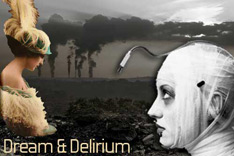
makeathon ....presented on 2.10.09
Below is a quicktime of the original movie you did not get to see:
projectone - gretl
|
2 Lens Often in dreams, I find myself watching from a disassociated POV. Above or along side of the action. At the worst, it seems like a taste of what I think delirium might be like in it's manic stages. This excercise emphasized that frustrating experience while treating it as a game of bioptic choice. Here is an example of what the experience might have been like:
Points of Inquiry
By forcing the audience to choose how to use their lens, I denied myself the power to design their individual experiences. Each viewing must have been completely unique due to the small aperture of the lenses. So, for myself, it was an excercise in realising my own illusions of control. Coincidently, as Sandy pointed out, by restricting the range of each person's view and giving them an increased latitude of movement, the viewers became more immersed within their restricted view than with a normal, large screen presentation. Methodology I shaped long tubes of black paper - one a triangle and the other a circle. Then while I projected a rapid video montage about the times surrounding the lives of Freud, Pavlov, WWI, the Dadaists, and the Surrealists, I asked the viewers to watch the video through the tubes. The music was by Chavez, an expressionistic 20th century composer. The apertures of the tubes were too small to allow viewers to see the entire video screen so the audience members were forced to choose which portions to watch - with no clues from me or the video as to what was important. The tubes were long enough that the viewers could move them over a lot of screen geography; in this way, they could move each eyepiece independently and gave them more latitude - a distinctly non-mammalian experience. |
judy thomas - austin tx - 512.448.1982 - judy@xozone.com